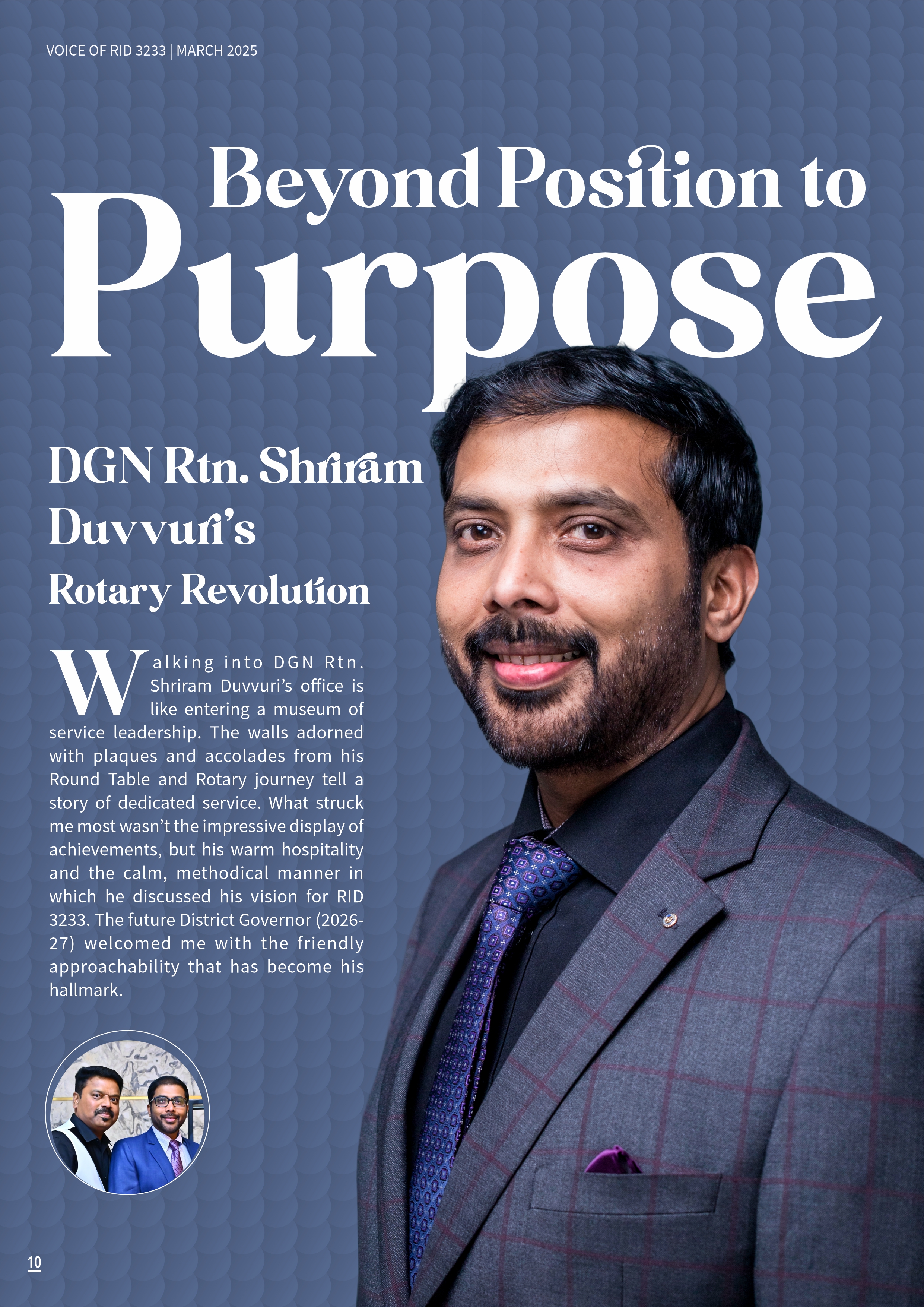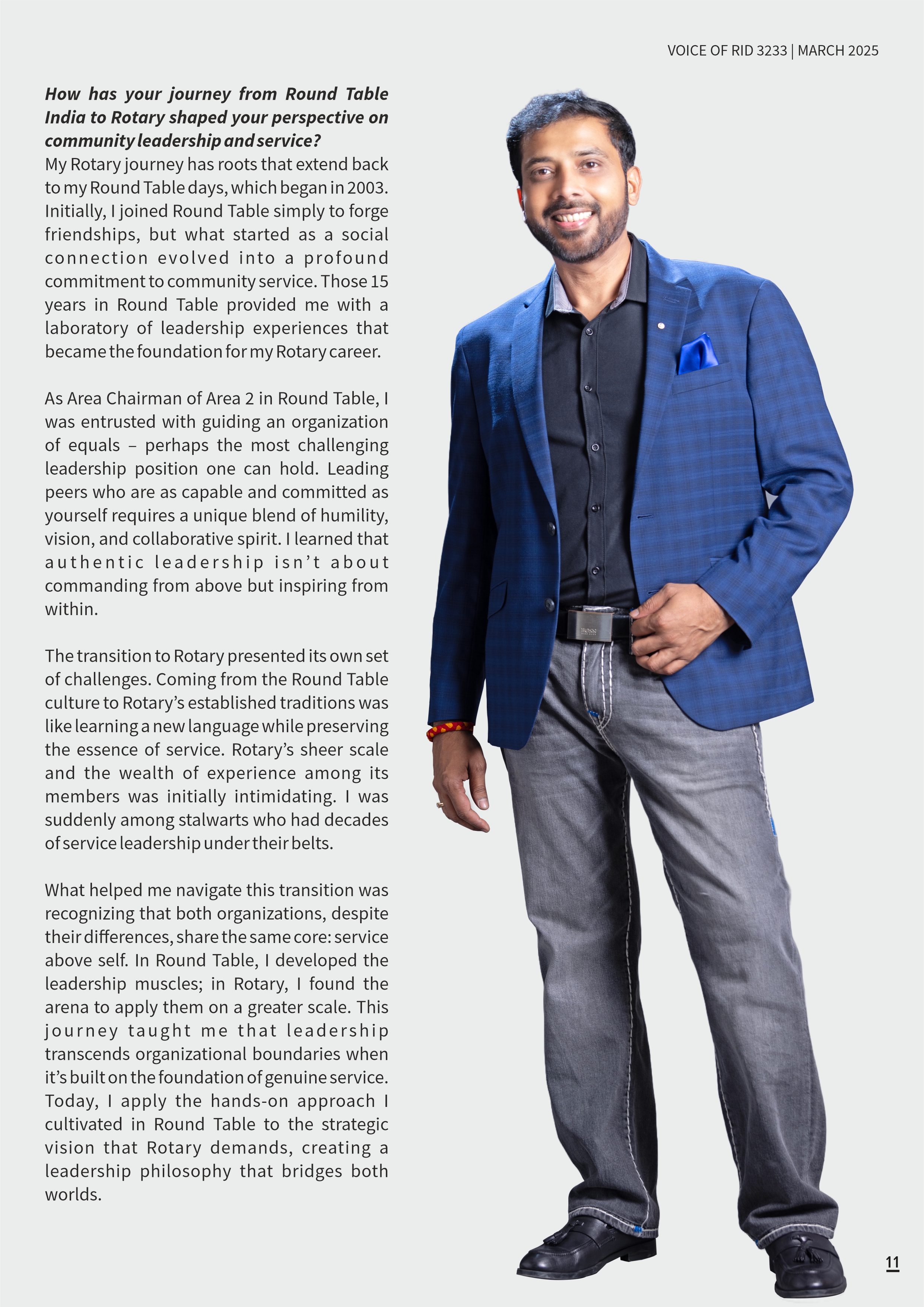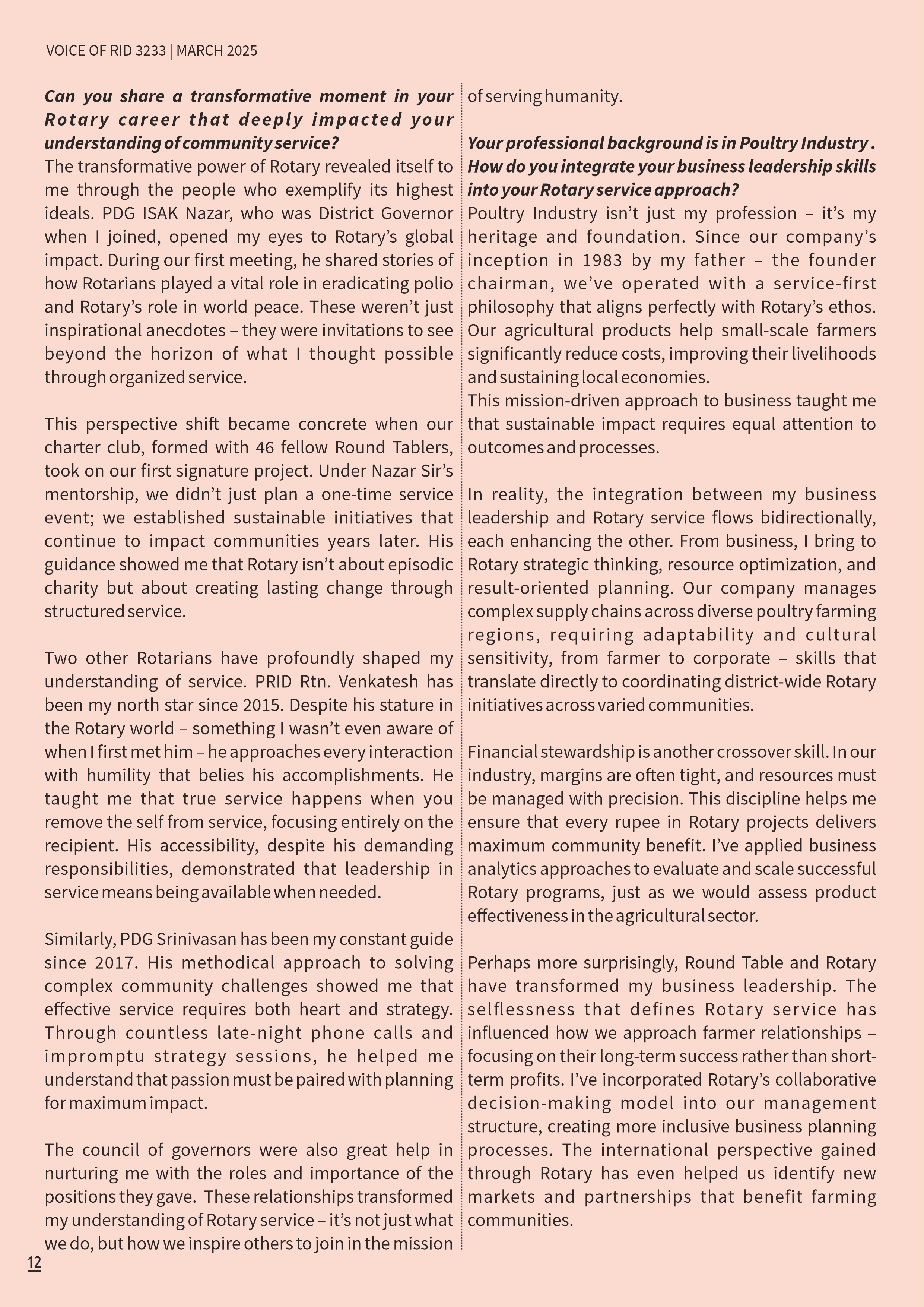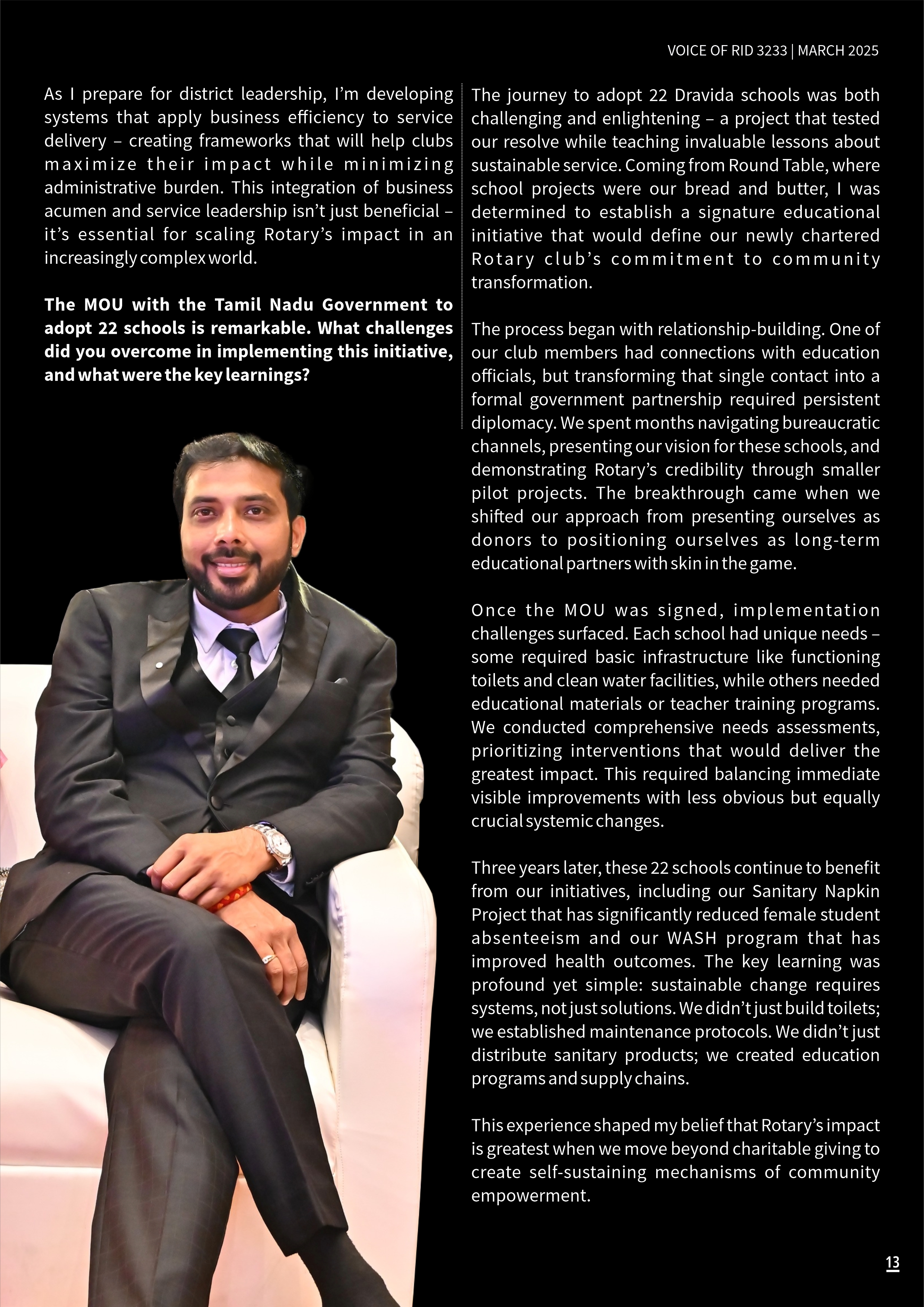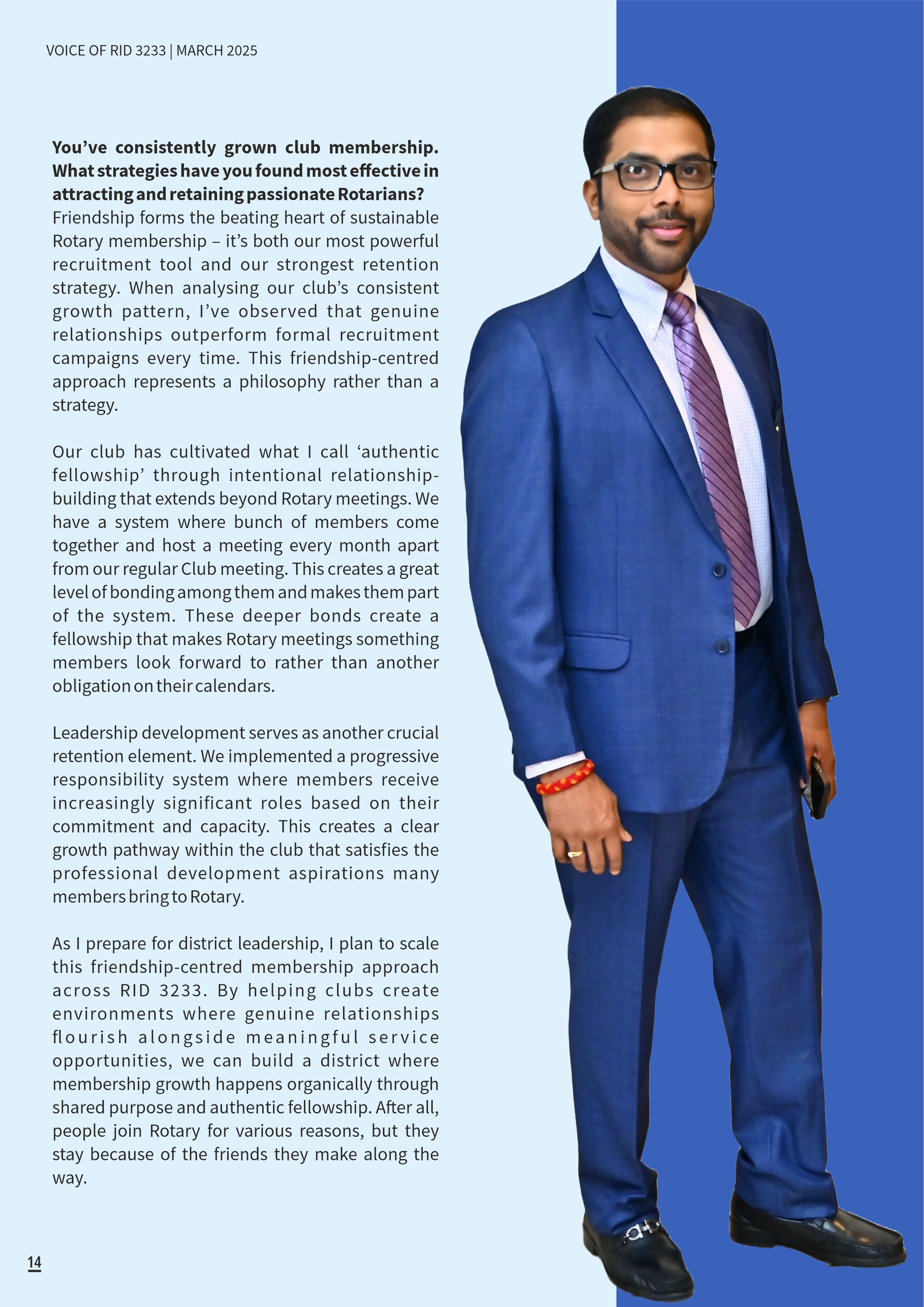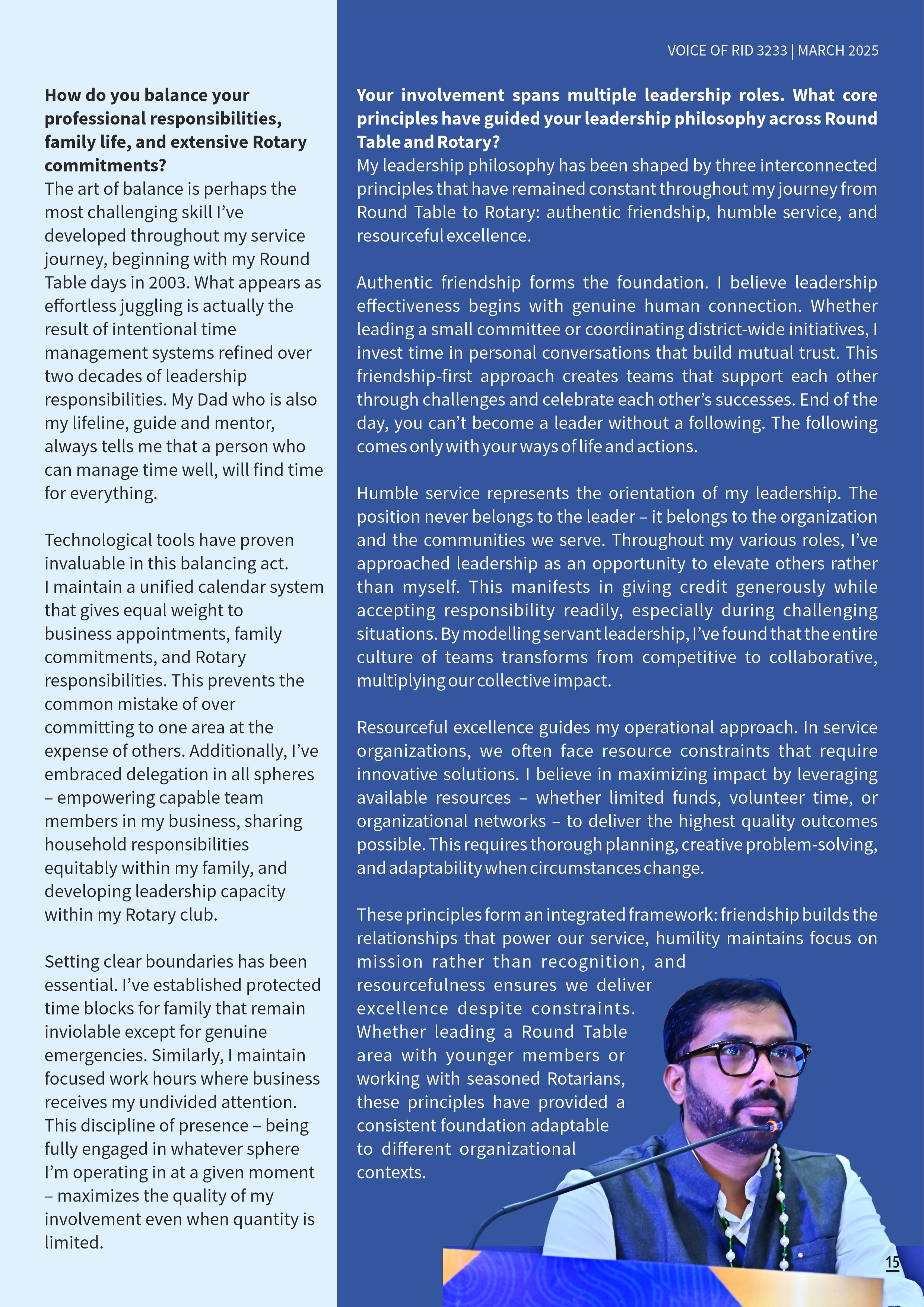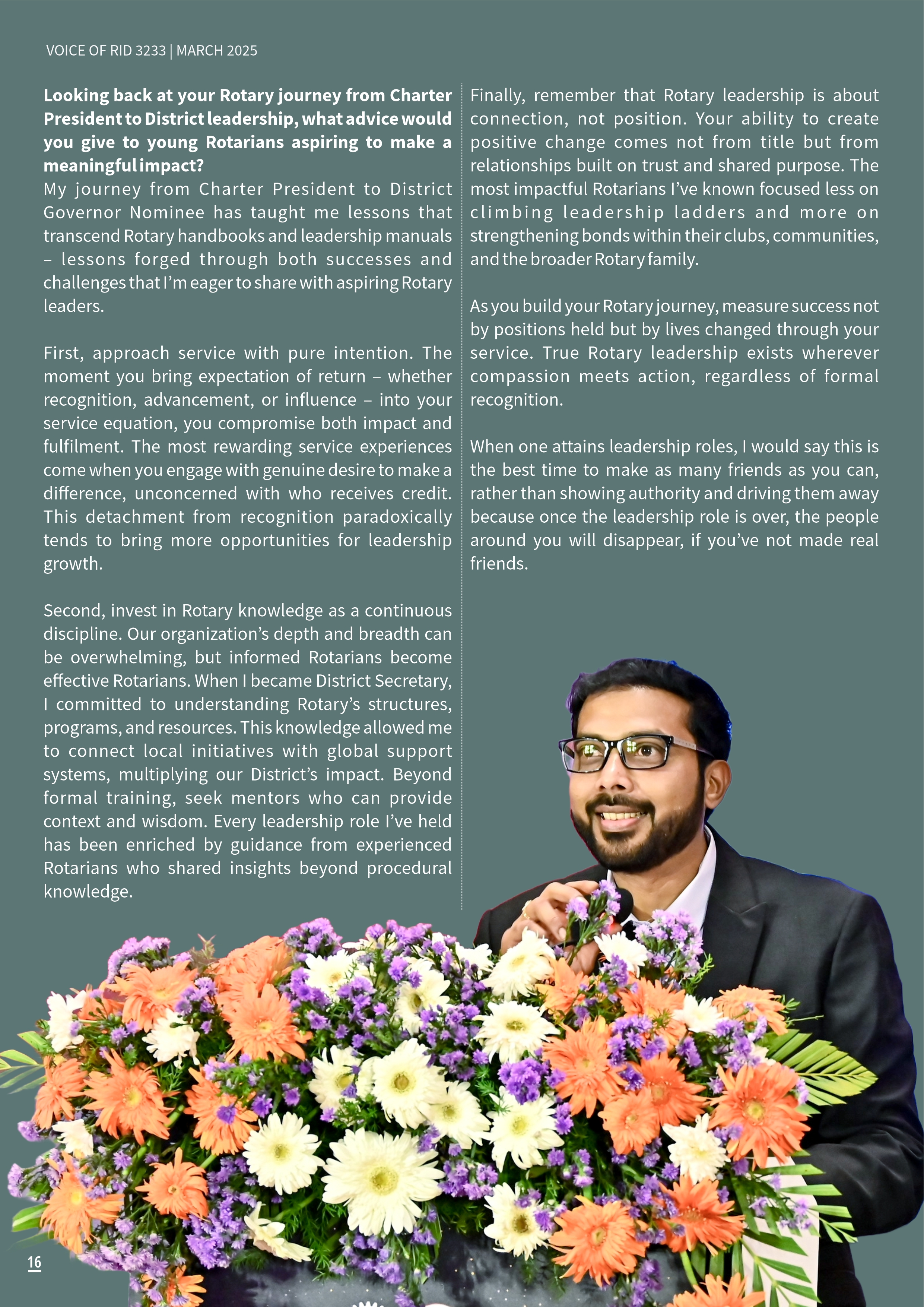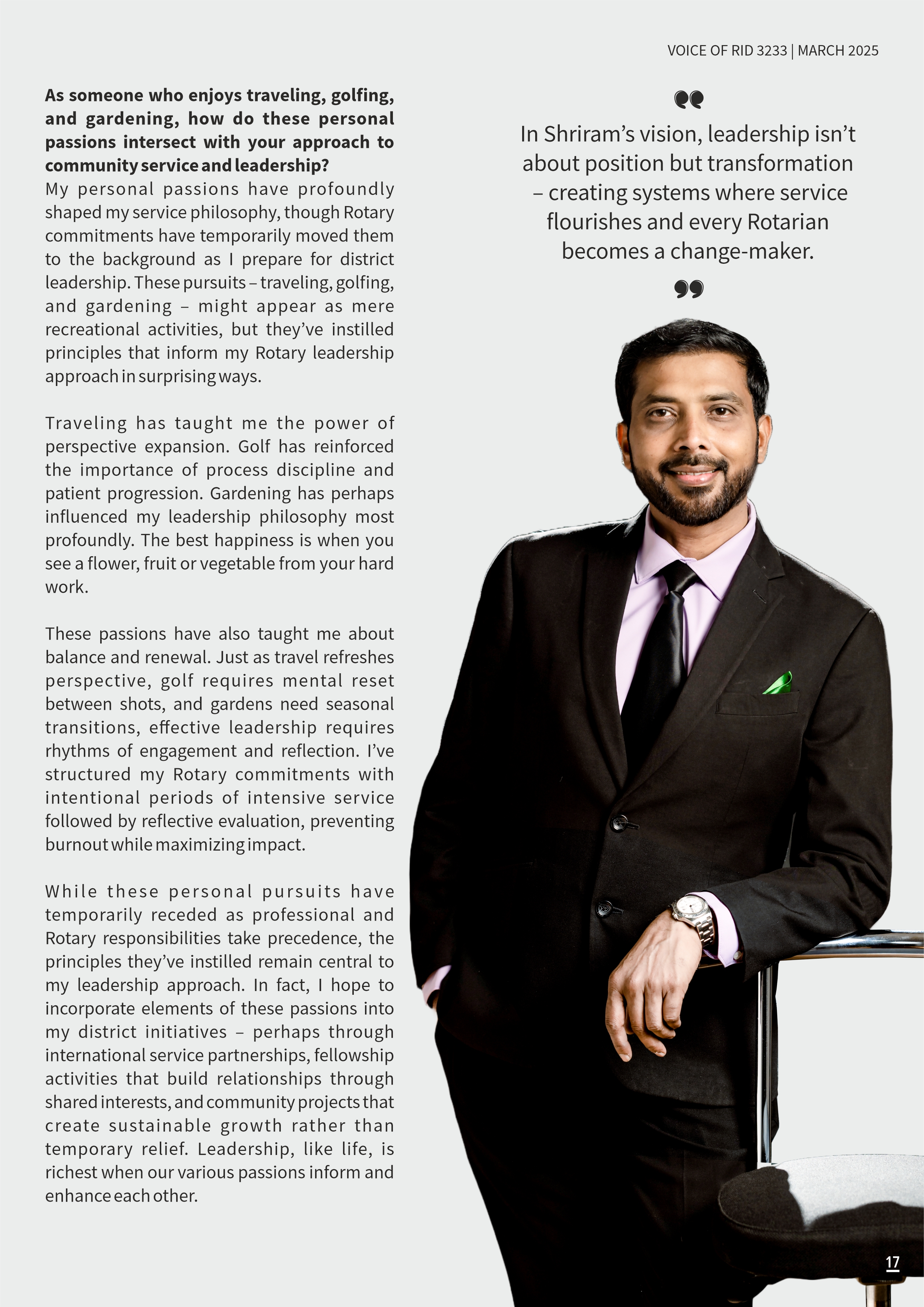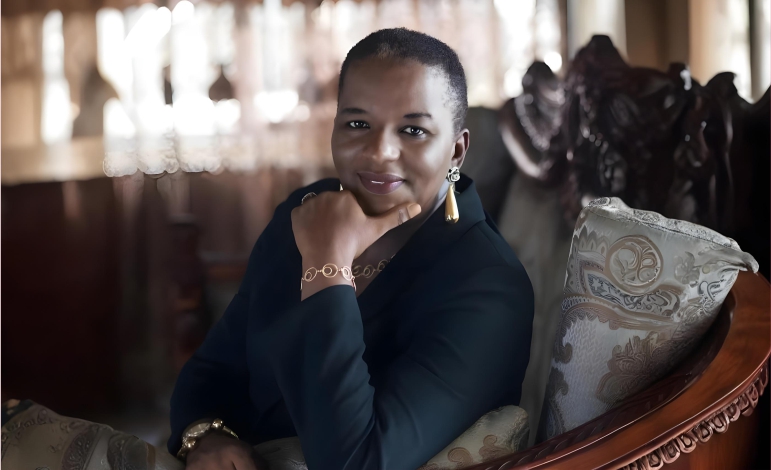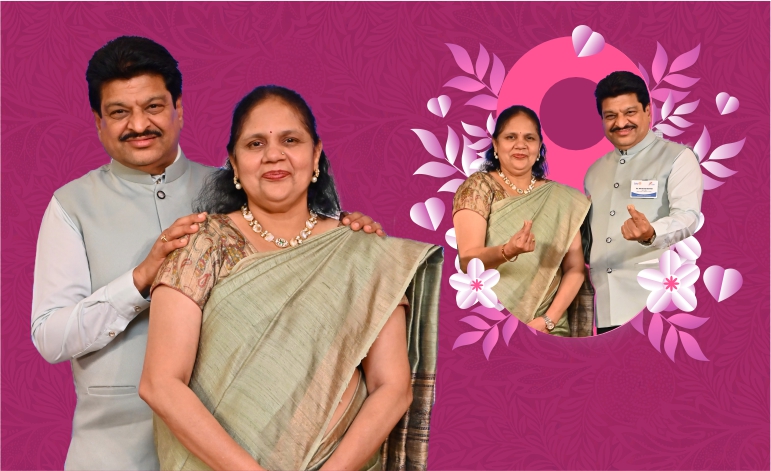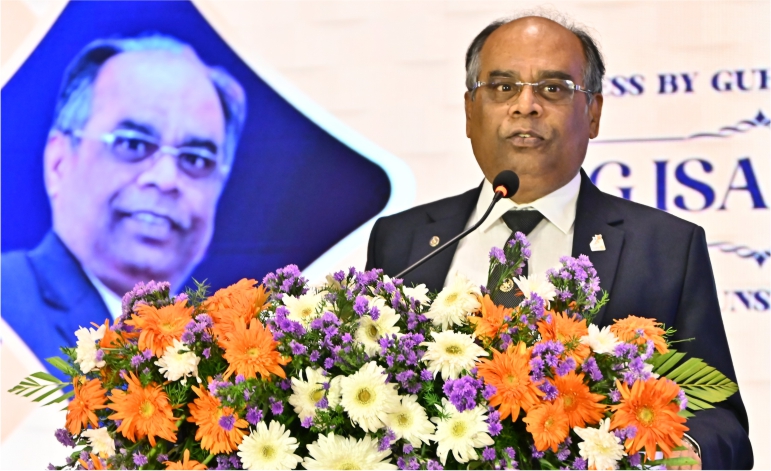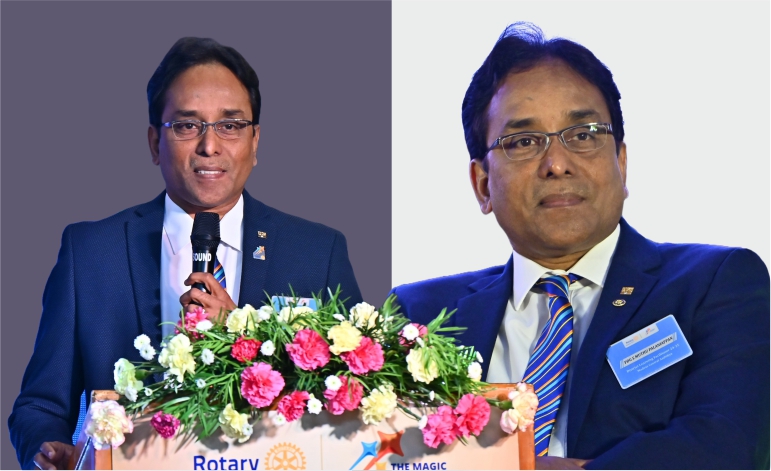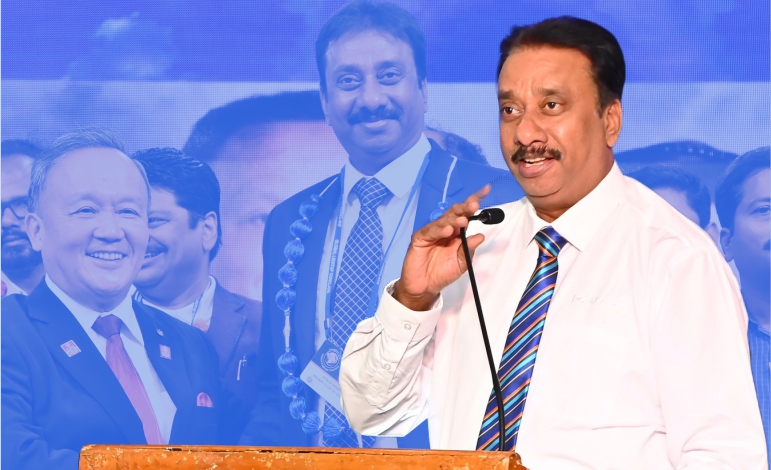Beyond Position to Purpose: Shriram Duvvuri’s Rotary Revolution
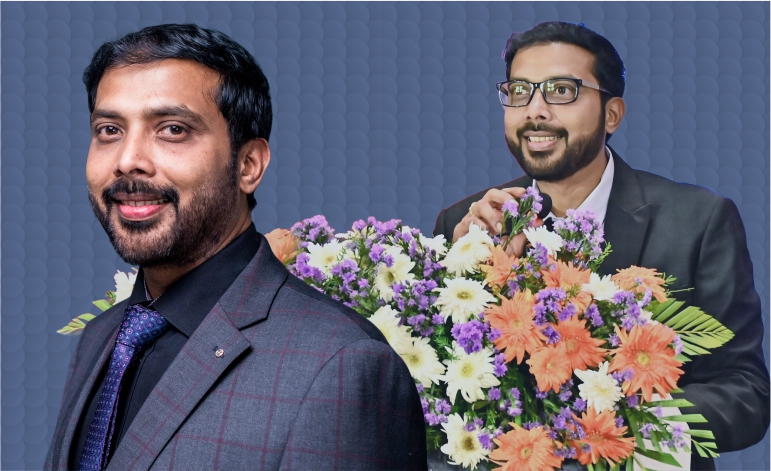
Walking into DGN Rtn. Shriram Duvvuri’s office is like entering a museum of service leadership. The walls adorned with plaques and accolades from his Round Table and Rotary journey tell a story of dedicated service. What struck me most wasn’t the impressive display of achievements, but his warm hospitality and the calm, methodical manner in which he discussed his vision for RID 3233. The future District Governor (2026-27) welcomed me with the friendly approachability that has become his hallmark.
How has your journey from Round Table India to Rotary shaped your perspective on community leadership and service?
My Rotary journey has roots that extend back to my Round Table days, which began in 2003. Initially, I joined Round Table simply to forge friendships, but what started as a social connection evolved into a profound commitment to community service. Those 15 years in Round Table provided me with a laboratory of leadership experiences that became the foundation for my Rotary career.
As Area Chairman of Area 2 in Round Table, I was entrusted with guiding an organization of equals – perhaps the most challenging leadership position one can hold. Leading peers who are as capable and committed as yourself requires a unique blend of humility, vision, and collaborative spirit. I learned that authentic leadership isn’t about commanding from above but inspiring from within.
The transition to Rotary presented its own set of challenges. Coming from the Round Table culture to Rotary’s established traditions was like learning a new language while preserving the essence of service. Rotary’s sheer scale and the wealth of experience among its members was initially intimidating. I was suddenly among stalwarts who had decades of service leadership under their belts.
What helped me navigate this transition was recognizing that both organizations, despite their differences, share the same core: service above self. In Round Table, I developed the leadership muscles; in Rotary, I found the arena to apply them on a greater scale. This journey taught me that leadership transcends organizational boundaries when it’s built on the foundation of genuine service. Today, I apply the hands-on approach I cultivated in Round Table to the strategic vision that Rotary demands, creating a leadership philosophy that bridges both worlds.
Can you share a transformative moment in your Rotary career that deeply impacted your understanding of community service?
The transformative power of Rotary revealed itself to me through the people who exemplify its highest ideals. PDG ISAK Nazar, who was District Governor when I joined, opened my eyes to Rotary’s global impact. During our first meeting, he shared stories of how Rotarians played a vital role in eradicating polio and Rotary’s role in world peace. These weren’t just inspirational anecdotes – they were invitations to see beyond the horizon of what I thought possible through organized service.
This perspective shift became concrete when our charter club, formed with 46 fellow Round Tablers, took on our first signature project. Under Nazar Sir’s mentorship, we didn’t just plan a one-time service event; we established sustainable initiatives that continue to impact communities years later. His guidance showed me that Rotary isn’t about episodic charity but about creating lasting change through structured service.
Two other Rotarians have profoundly shaped my understanding of service. PRID Rtn. Venkatesh has been my north star since 2015. Despite his stature in the Rotary world – something I wasn’t even aware of when I first met him – he approaches every interaction with humility that belies his accomplishments. He taught me that true service happens when you remove the self from service, focusing entirely on the recipient. His accessibility, despite his demanding responsibilities, demonstrated that leadership in service means being available when needed.
Similarly, PDG Srinivasan has been my constant guide since 2017. His methodical approach to solving complex community challenges showed me that effective service requires both heart and strategy. Through countless late-night phone calls and impromptu strategy sessions, he helped me understand that passion must be paired with planning for maximum impact.
The council of governors were also great help in nurturing me with the roles and importance of the positions they gave. These relationships transformed my understanding of Rotary service – it’s not just what we do, but how we inspire others to join in the mission of serving humanity.
Your professional background is in Poultry Industry . How do you integrate your business leadership skills into your Rotary service approach?
Poultry Industry isn’t just my profession – it’s my heritage and foundation. Since our company’s inception in 1983 by my father – the founder chairman, we’ve operated with a service-first philosophy that aligns perfectly with Rotary’s ethos. Our agricultural products help small-scale farmers significantly reduce costs, improving their livelihoods and sustaining local economies. This mission-driven approach to business taught me that sustainable impact requires equal attention to outcomes and processes.
In reality, the integration between my business leadership and Rotary service flows bidirectionally, each enhancing the other. From business, I bring to Rotary strategic thinking, resource optimization, and result-oriented planning. Our company manages complex supply chains across diverse poultry farming regions, requiring adaptability and cultural sensitivity, from farmer to corporate – skills that translate directly to coordinating district-wide Rotary initiatives across varied communities.
Financial stewardship is another crossover skill. In our industry, margins are often tight, and resources must be managed with precision. This discipline helps me ensure that every rupee in Rotary projects delivers maximum community benefit. I’ve applied business analytics approaches to evaluate and scale successful Rotary programs, just as we would assess product effectiveness in the agricultural sector.
Perhaps more surprisingly, Round Table and Rotary have transformed my business leadership. The selflessness that defines Rotary service has influenced how we approach farmer relationships – focusing on their long-term success rather than short-term profits. I’ve incorporated Rotary’s collaborative decision-making model into our management structure, creating more inclusive business planning processes. The international perspective gained through Rotary has even helped us identify new markets and partnerships that benefit farming communities.
As I prepare for district leadership, I’m developing systems that apply business efficiency to service delivery – creating frameworks that will help clubs maximize their impact while minimizing administrative burden. This integration of business acumen and service leadership isn’t just beneficial – it’s essential for scaling Rotary’s impact in an increasingly complex world.
The MOU with the Tamil Nadu Government to adopt 22 schools is remarkable. What challenges did you overcome in implementing this initiative, and what were the key learnings?
The journey to adopt 22 Dravida schools was both challenging and enlightening – a project that tested our resolve while teaching invaluable lessons about sustainable service. Coming from Round Table, where school projects were our bread and butter, I was determined to establish a signature educational initiative that would define our newly chartered Rotary club’s commitment to community transformation.
The process began with relationship-building. One of our club members had connections with education officials, but transforming that single contact into a formal government partnership required persistent diplomacy. We spent months navigating bureaucratic channels, presenting our vision for these schools, and demonstrating Rotary’s credibility through smaller pilot projects. The breakthrough came when we shifted our approach from presenting ourselves as donors to positioning ourselves as long-term educational partners with skin in the game.
Once the MOU was signed, implementation challenges surfaced. Each school had unique needs – some required basic infrastructure like functioning toilets and clean water facilities, while others needed educational materials or teacher training programs. We conducted comprehensive needs assessments, prioritizing interventions that would deliver the greatest impact. This required balancing immediate visible improvements with less obvious but equally crucial systemic changes.
Three years later, these 22 schools continue to benefit from our initiatives, including our Sanitary Napkin Project that has significantly reduced female student absenteeism and our WASH program that has improved health outcomes. The key learning was profound yet simple: sustainable change requires systems, not just solutions. We didn’t just build toilets; we established maintenance protocols. We didn’t just distribute sanitary products; we created education programs and supply chains.
This experience shaped my belief that Rotary’s impact is greatest when we move beyond charitable giving to create self-sustaining mechanisms of community empowerment.
You’ve consistently grown club membership. What strategies have you found most effective in attracting and retaining passionate Rotarians?
Friendship forms the beating heart of sustainable Rotary membership – it’s both our most powerful recruitment tool and our strongest retention strategy. When analysing our club’s consistent growth pattern, I’ve observed that genuine relationships outperform formal recruitment campaigns every time. This friendship-centred approach represents a philosophy rather than a strategy.
Our club has cultivated what I call ‘authentic fellowship’ through intentional relationship-building that extends beyond Rotary meetings. We have a system where bunch of members come together and host a meeting every month apart from our regular Club meeting. This creates a great level of bonding among them and makes them part of the system. These deeper bonds create a fellowship that makes Rotary meetings something members look forward to rather than another obligation on their calendars.
Leadership development serves as another crucial retention element. We implemented a progressive responsibility system where members receive increasingly significant roles based on their commitment and capacity. This creates a clear growth pathway within the club that satisfies the professional development aspirations many members bring to Rotary.
As I prepare for district leadership, I plan to scale this friendship-centred membership approach across RID 3233. By helping clubs create environments where genuine relationships flourish alongside meaningful service opportunities, we can build a district where membership growth happens organically through shared purpose and authentic fellowship. After all, people join Rotary for various reasons, but they stay because of the friends they make along the way.
How do you balance your professional responsibilities, family life, and extensive Rotary commitments?
The art of balance is perhaps the most challenging skill I’ve developed throughout my service journey, beginning with my Round Table days in 2003. What appears as effortless juggling is actually the result of intentional time management systems refined over two decades of leadership responsibilities. My Dad who is also my lifeline, guide and mentor, always tells me that a person who can manage time well, will find time for everything.
Technological tools have proven invaluable in this balancing act. I maintain a unified calendar system that gives equal weight to business appointments, family commitments, and Rotary responsibilities. This prevents the common mistake of overcommitting to one area at the expense of others. Additionally, I’ve embraced delegation in all spheres – empowering capable team members in my business, sharing household responsibilities equitably within my family, and developing leadership capacity within my Rotary club.
Setting clear boundaries has been essential. I’ve established protected time blocks for family that remain inviolable except for genuine emergencies. Similarly, I maintain focused work hours where business receives my undivided attention. This discipline of presence – being fully engaged in whatever sphere I’m operating in at a given moment – maximizes the quality of my involvement even when quantity is limited.
Your involvement spans multiple leadership roles. What core principles have guided your leadership philosophy across Round Table and Rotary?
My leadership philosophy has been shaped by three interconnected principles that have remained constant throughout my journey from Round Table to Rotary: authentic friendship, humble service, and resourceful excellence.
Authentic friendship forms the foundation. I believe leadership effectiveness begins with genuine human connection. Whether leading a small committee or coordinating district-wide initiatives, I invest time in personal conversations that build mutual trust. This friendship-first approach creates teams that support each other through challenges and celebrate each other’s successes. End of the day, you can’t become a leader without a following. The following comes only with your ways of life and actions.
Humble service represents the orientation of my leadership. The position never belongs to the leader – it belongs to the organization and the communities we serve. Throughout my various roles, I’ve approached leadership as an opportunity to elevate others rather than myself. This manifests in giving credit generously while accepting responsibility readily, especially during challenging situations. By modelling servant leadership, I’ve found that the entire culture of teams transforms from competitive to collaborative, multiplying our collective impact.
Resourceful excellence guides my operational approach. In service organizations, we often face resource constraints that require innovative solutions. I believe in maximizing impact by leveraging available resources – whether limited funds, volunteer time, or organizational networks – to deliver the highest quality outcomes possible. This requires thorough planning, creative problem-solving, and adaptability when circumstances change.
These principles form an integrated framework: friendship builds the relationships that power our service, humility maintains focus on mission rather than recognition, and resourcefulness ensures we deliver excellence despite constraints. Whether leading a Round Table area with younger members or working with seasoned Rotarians, these principles have provided a consistent foundation adaptable to different organizational contexts.
Looking back at your Rotary journey from Charter President to District leadership, what advice would you give to young Rotarians aspiring to make a meaningful impact?
My journey from Charter President to District Governor Nominee has taught me lessons that transcend Rotary handbooks and leadership manuals – lessons forged through both successes and challenges that I’m eager to share with aspiring Rotary leaders.
First, approach service with pure intention. The moment you bring expectation of return – whether recognition, advancement, or influence – into your service equation, you compromise both impact and fulfilment. The most rewarding service experiences come when you engage with genuine desire to make a difference, unconcerned with who receives credit. This detachment from recognition paradoxically tends to bring more opportunities for leadership growth.
Second, invest in Rotary knowledge as a continuous discipline. Our organization’s depth and breadth can be overwhelming, but informed Rotarians become effective Rotarians. When I became District Secretary, I committed to understanding Rotary’s structures, programs, and resources. This knowledge allowed me to connect local initiatives with global support systems, multiplying our District’s impact. Beyond formal training, seek mentors who can provide context and wisdom. Every leadership role I’ve held has been enriched by guidance from experienced Rotarians who shared insights beyond procedural knowledge.
Finally, remember that Rotary leadership is about connection, not position. Your ability to create positive change comes not from title but from relationships built on trust and shared purpose. The most impactful Rotarians I’ve known focused less on climbing leadership ladders and more on strengthening bonds within their clubs, communities, and the broader Rotary family.
As you build your Rotary journey, measure success not by positions held but by lives changed through your service. True Rotary leadership exists wherever compassion meets action, regardless of formal recognition.
When one attains leadership roles, I would say this is the best time to make as many friends as you can, rather than showing authority and driving them away because once the leadership role is over, the people around you will disappear, if you’ve not made real friends.
As someone who enjoys traveling, golfing, and gardening, how do these personal passions intersect with your approach to community service and leadership?
My personal passions have profoundly shaped my service philosophy, though Rotary commitments have temporarily moved them to the background as I prepare for district leadership. These pursuits – traveling, golfing, and gardening – might appear as mere recreational activities, but they’ve instilled principles that inform my Rotary leadership approach in surprising ways.
Traveling has taught me the power of perspective expansion. Golf has reinforced the importance of process discipline and patient progression. Gardening has perhaps influenced my leadership philosophy most profoundly. The best happiness is when you see a flower, fruit or vegetable from your hard work.
These passions have also taught me about balance and renewal. Just as travel refreshes perspective, golf requires mental reset between shots, and gardens need seasonal transitions, effective leadership requires rhythms of engagement and reflection. I’ve structured my Rotary commitments with intentional periods of intensive service followed by reflective evaluation, preventing burnout while maximizing impact.
While these personal pursuits have temporarily receded as professional and Rotary responsibilities take precedence, the principles they’ve instilled remain central to my leadership approach. In fact, I hope to incorporate elements of these passions into my district initiatives – perhaps through international service partnerships, fellowship activities that build relationships through shared interests, and community projects that create sustainable growth rather than temporary relief. Leadership, like life, is richest when our various passions inform and enhance each other.
“In Shriram’s vision, leadership isn’t about position but transformation – creating systems where service flourishes and every Rotarian becomes a change-maker.”
